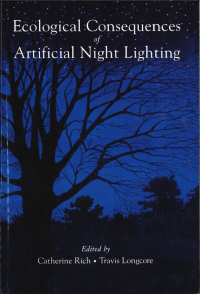COVER ONLY
This chapter begins with a review of the biology of mammalian vision, including the extensive literature on how moonlight affects nocturnal behavior of mammals and how light influences mammalian biological clocks. It then discusses several classes of likely effects of artificial night lighting on mammals, namely disruption of foraging patterns, increased predation risk, disruption of biological clocks, increased mortality on roads, and disruption of dispersal movements through artificially lighted landscapes. It includes recommendations for experiments or observations that could advance our understanding of the most likely and significant effects.
Beier, P. 2006. Effects of artificial night lighting on terrestrial mammals. In Ecological Consequences of Artificial Night Lighting, edited by C. Rich and T. Longcore, pp. 19–42. Washington, D.C.: Island Press.


